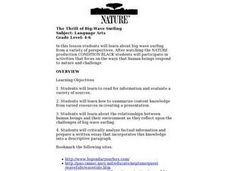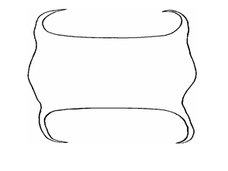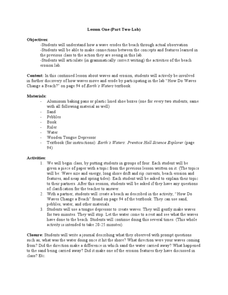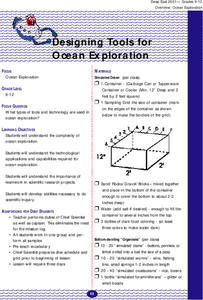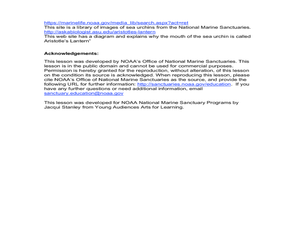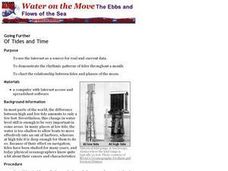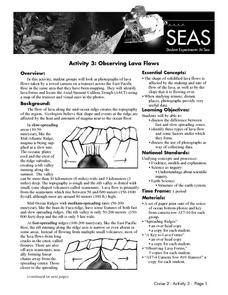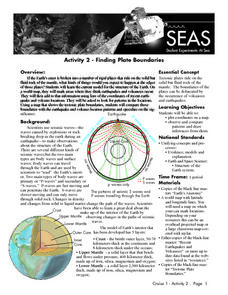Curated OER
History and Oceanography
Students identify the accomplishments in oceanography from 17th-19th century, construct a time line with the scientists in chronological order, and discuss the parallels of oceanographic contributions with those in other areas of science...
Curated OER
Creatures of the Ocean
Second graders examine the characteristics of a specific ocean creature. In pairs, 2nd graders create a graphic organizer to list categories and supporting details of the ocean creature. Students review data and use it to write a report...
Curated OER
The Thrill of Big-Wave Surfing
Students view a PBS Nature program about big-wave surfing and participate in a class discussion about their experiences with surfing, body boarding, or body surfing. Students create a drawing based on a reading and post their art around...
Curated OER
Water Density
Students identify and analyze the concept of density using the formula, density equals mass divided by volume. They review the differences in salinity levels of the ocean and note that the changes in density are caused by wind and...
Curated OER
Skates
Students gain understanding of structure, characteristics, and basic needs of living things and their role in world, identify parts of skate, observe details of skate's body and skate egg case, and identify unique characteristics of skates.
Curated OER
Light Up the Deep Sea
Young scholars simulate bioluminescence in the marine environment. In this marine science lesson, students investigate how animals in the deep ocean communicate with each other. They explain the function of bioluminescence among marine...
Curated OER
AUSTRALIA
Students examine the different types of barrier reefs and how they are formed. In this barrier reef lesson students complete several activities on coral reefs.
Curated OER
How Do Waves Change a Beach?
Students conduct an experiment on beach erosion. In this earth science lesson plan, students create a beach model and use tongue depressor to produce waves. They write a journal about their observations.
Curated OER
Modelling Ocean Currents
Students construct a replica of the Atlantic ocean given certain parameters. In this earth science instructional activity, students draw their own map of ocean currents. They answer questions related to the activity.
Curated OER
Lights in the Deep
Students describe, compare, and contrast bioluminescence, fluorescence, phosphorescence, and chemiluminescence. They explain the role of three major components of bioluminescent systems. They ex
Curated OER
If I Can't See It, How Do I Know It's There?
Young scholars build a model ocean using a variety of materials representing the various levels of the ocean. They collect data about the ocean floor in a partner activity. They practice working with topographical mapping grids.
Curated OER
Are You Related?
High schoolers study microsatellite markers and explain how they might be used to identify populations. They use data to make inferences about the populations of deep-sea corals.
Curated OER
Designing Tools for Ocean Exploration
Students research the methods and tools used in ocean exploration. They, in groups, simulate an ocean exploration and consider what tools facilitate the exploration's objectives.
Curated OER
Sea Urchins - Diadema Antillarum
Students investigate oceanography by painting sea life. In this crustacean lesson, students identify sea urchins in our ocean environments and describe the functionality of their spherical-shaped bodies. Students design their own sea...
Curated OER
Obis Oil Spill
Students explore environmental challenges by participating in an oil spill simulation. In this water safety instructional activity, students discuss why oil spills happen and how their impact affects the entire ecosystem. Students...
Curated OER
Of Tides and Time
Students use the internet to research how the time of day affects the tides. They work together to develop a demonstration of the tide patterns for a month. They create a chart showing the relationship between tides and the phases of...
Curated OER
Water Currents
Middle schoolers demonstrate how ocean currents are influenced by changes in density. They discover that temperature and salintiy affect density as well. They participate in a short experiment to end the lesson.
Curated OER
SOS!
Learners examine natural and man-made threats to sea turtles. They create sea turtle mobiles while studying the range, environment, predators of and threats to sea turtles.
Curated OER
Locating Vent Fields Using CTD Data
Students describe the way hydrothermal vents work. Students work on locating vent regions through remote collection of data about water temperature and density. Comparing density and temperatures graphs, students search for indicators...
Curated OER
Observing Lava Flows
Learners examine the difference between fast and slow spreading lava flows. They identify various types of lava flow and determine the factors that cause them to form. Viewing photographs of lava flows, students working in groups,...
Curated OER
Recent Volcanoes And Earthquakes:
Students investigate the current model for the structure of the Earth. On a world map, they mark areas where they think earthquakes and volcanoes occur and compare those areas with earthquake and volcano location patterns.
Curated OER
Density and Convection Currents
Students listen as the teacher explains convection currents in the ocean. They experiment with finding a smoking match in the classroom with their eyes closed. Students discuss what might effect their ability to pinpoint the smoke...
Curated OER
Activity 1: Please Pass the Energy, Food Webs in the Upper Ocean and Hydrothermal Vent Communities
Middle schoolers create food webs for two different ocean communities. They are given cards showing organisms from the surface of the ocean. They arrange them in order of who eats whom. After this class activity, students create a food...
Curated OER
Activity 2: How Do You Get Your Energy?
Students receive informational handouts about photosynthesis, chemosynthesis and tubeworms (included with the lesson). Using the "Bacteriology Experiment Plan" handout, students compare the amount of bacteria found in two locations. They...
Other popular searches
- Identify Oceans and Seas
- Oceans and Seas Maps
- Oceans and Seas Preschool
- Balm Oceans and Seas
- Oceans and Seas Worksheet
- Blm Oceans and Seas
- Major Cities/oceans/seas


